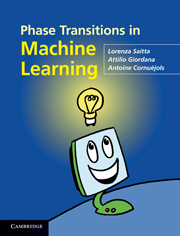Book contents
- Frontmatter
- Contents
- Preface
- Acknowledgments
- Notation
- 1 Introduction
- 2 Statistical physics and phase transitions
- 3 The satisfiability problem
- 4 Constraint satisfaction problems
- 5 Machine learning
- 6 Searching the hypothesis space
- 7 Statistical physics and machine learning
- 8 Learning, SAT, and CSP
- 9 Phase transition in FOL covering test
- 10 Phase transitions and relational learning
- 11 Phase transitions in grammatical inference
- 12 Phase transitions in complex systems
- 13 Phase transitions in natural systems
- 14 Discussion and open issues
- Appendix A Phase transitions detected in two real cases
- Appendix B An intriguing idea
- References
- Index
1 - Introduction
Published online by Cambridge University Press: 05 August 2012
- Frontmatter
- Contents
- Preface
- Acknowledgments
- Notation
- 1 Introduction
- 2 Statistical physics and phase transitions
- 3 The satisfiability problem
- 4 Constraint satisfaction problems
- 5 Machine learning
- 6 Searching the hypothesis space
- 7 Statistical physics and machine learning
- 8 Learning, SAT, and CSP
- 9 Phase transition in FOL covering test
- 10 Phase transitions and relational learning
- 11 Phase transitions in grammatical inference
- 12 Phase transitions in complex systems
- 13 Phase transitions in natural systems
- 14 Discussion and open issues
- Appendix A Phase transitions detected in two real cases
- Appendix B An intriguing idea
- References
- Index
Summary
Machine learning's roots
Learning involves vital functions at different levels of consciousness, starting with the recognition of sensory stimuli up to the acquisition of complex notions for sophisticated abstract reasoning. Even though learning escapes precise definition there is general agreement on Langley's idea (Langley, 1986) of learning as a set of “mechanisms through which intelligent agents improve their behavior over time”, which seems reasonable once a sufficiently broad view of “agent” is taken. Machine learning has its roots in several disciplines, notably statistics, pattern recognition, the cognitive sciences, and control theory. Its main goal is to help humans in constructing programs that cannot be built up manually and programs that learn from experience. Another goal of machine learning is to provide computational models for human learning, thus supporting cognitive studies of learning.
Classification
Among the large variety of tasks that constitute the body of machine learning, one has received attention from the beginning: the acquiring of knowledge for performing classification. From this perspective machine learning can be described roughly as the process of discovering regularities from a set of available data and extrapolating these regularities to new data.
Machine learning as an algorithm
Over the years, machine learning has been understood in different ways. At first it was considered mainly as an algorithmic process. One of the first approaches to automated learning was proposed by Gold in his “learning in the limit” paradigm (Gold, 1967).
- Type
- Chapter
- Information
- Phase Transitions in Machine Learning , pp. 1 - 11Publisher: Cambridge University PressPrint publication year: 2011



